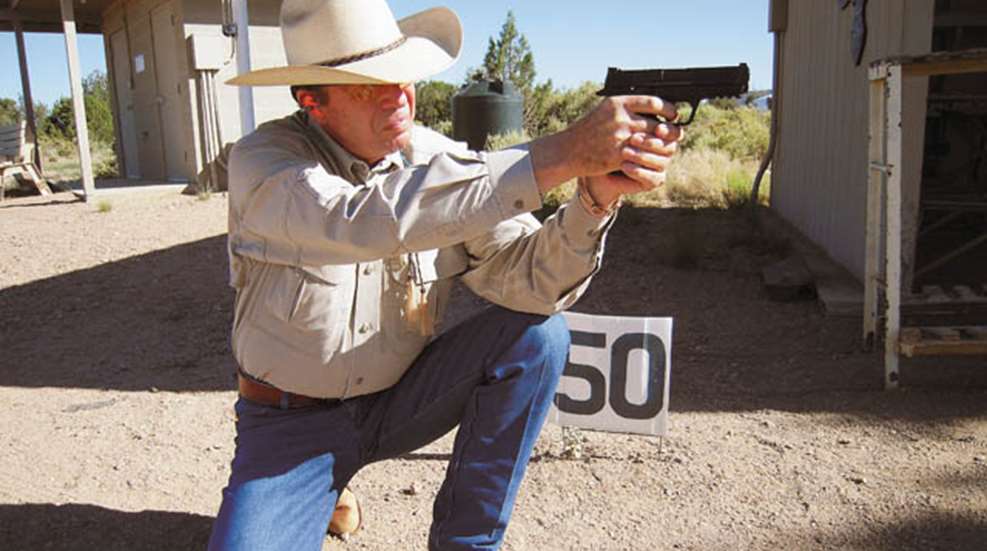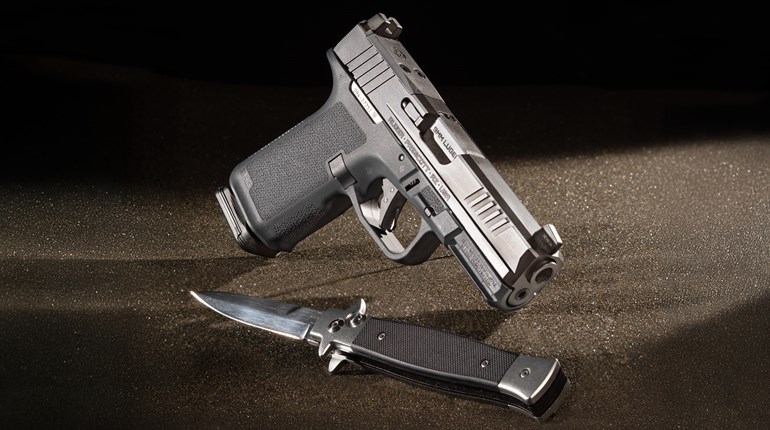
The evening before the trouble, Davis and James had been engaged in a card game that ended in an argument. Others suggest the bad blood rose over a woman both men were involved with. Regardless, harsh words were exchanged along with some threats.
The next day both men met downtown, across the town square from each other. Davis started the ball by pulling a pistol and firing. James also drew a pistol and, steadying it with both hands, fired one shot that ended the attack. Interestingly, James' fight-stopping hit was at approximately 75 yards.
This particular fight took place in July 1865, in Springfield, MO. Davis "Dave" Tutt was hit in the heart by James Butler Hickok. It's uncertain if Hickok was using a .44 Colt Dragoon or if he had already switched to the .36-caliber Colt Navy that would become his trademark. We do know he was armed with a cap-and-ball revolver utilizing the skimpy sights for which those guns are known. Regardless, Hickok fought with what he had at hand, and this is one example of the long-range capabilities of defensive handguns.
Capt. Frank Hamer, of Bonnie and Clyde fame, was another shootist who regularly practiced long-range shooting. Hamer, a deadly rifle shot, knew a rifle might not be readily available when danger threatened. He was once challenged to a shooting match by a local sheriff. When Hamer pointed out a distant rock and proceeded to hit it with his .45 Colt Single Action Army, the sheriff quit in disgust. "I didn't know you wanted to match pistols at rifle ranges," he said as he walked off.
Today, handgunners are taught defensive skills at ranges that generally run from 3 to 15 yards. Certainly, this is the range at which most deadly attacks occur, but any defensive training worth its salt should also help students understand the performance of their handguns at much greater distances.
If a person has any advanced notice of a pending gunfight, he is wise to get his hands on a repeating shotgun or rifle. Or, he might just avoid the encounter altogether. The handgun is of value only because it is easy to carry and therefore is available when an attack occurs. Realistically, we know a person will often be forced to fight with what he is carrying simply because there is no time to get to other, more suitable weapons. It is easy to imagine a number of scenarios where long-range handgunning skills can pay off.
For example, consider a citizen leaving a large shopping center when he is attacked. His gunfire drives off the attackers, who take cover behind parked cars and fire at 35 to 40 yards. The citizen cannot attack or retreat and must take cover behind a nearby vehicle and return fire. Superior handgunning skills can quickly bring this sort of attack to an end, or at least keep the attackers at bay until police arrive.
Obviously, in any kind of rural setting, ranges at which an attack may occur can be much longer than one might expect. It is likely that a person could be pinned down by rifle fire and have nothing with which to respond except his handgun. Logic tells us the bad guys are probably not going to agree to a time-out while the citizen retrieves the rifle from his pickup.
For these reasons, part of defensive-handgun practice ought to involve some shooting at longer ranges. With practice, it will become apparent how well even small hideout guns can perform at 50 yards and beyond. Since bullets will begin to drop noticeably at longer ranges, it is often necessary to aim higher on the target. Bullet drop is directly related to caliber, bullet weight and velocity, so it is important to check a load to determine necessary holdover. Using a .38 Spl. +P load, holding where the target's neck joins the body may be required for center hits at 50 yards. On the other hand, with full-house .357 Mag. or .44 Mag. loads, one might be able to hold dead on and still get fight-stopping hits.
I recall one fun afternoon when a bunch of us peace officers decided to try our off-duty guns at long range. The target was a 50-gallon trash barrel at 100 yards. In no time at all, we were getting far more hits than misses with our 2-inch, .38-caliber revolvers. And our misses were still close enough to keep a bad guy ducking. As range increases, it becomes even more critical to pay due attention to sight picture, trigger squeeze and breathing. Practice improves these skills.
Most gunfights occur at ranges from 0 to 7 yards. At these ranges, just about anyone is a good shot. For the handgunner who practices, distance becomes your friend. By creating distance, your shooting skills can take over and win the day. So, whenever possible, defensive handgunners should try to increase distance as an attack becomes imminent.
Also, because criminals rarely practice at extended distances, their ability to hit you quickly diminishes. In this sort of attack, the armed citizen is wise to make use of cover. Getting behind cover, assuming a solid shooting stance and paying attention to marksmanship can save the day. Should a disturbance in the front yard become an armed attack, the defensive handgunner avoids advancing on his attackers. Instead, he steps back into the house, creating distance and making use of protective cover inside.
Most practice should involve developing a response to the short-range encounters we are most likely to face. However, about 10 percent of practice should involve shooting at longer ranges. Even in dry-fire practice, one can incorporate handgun presentation with a move to cover, or backward or laterally to create distance.
Defensive handgun practice at longer ranges may cause the shooter to re-evaluate his choice of a personal-defense handgun and ammunition. It will definitely improve marksmanship skills. And it will certainly drive home the fact that you need to learn to fight with what you carry. Nothing stops a fight like a center hit—especially one from distance.






































